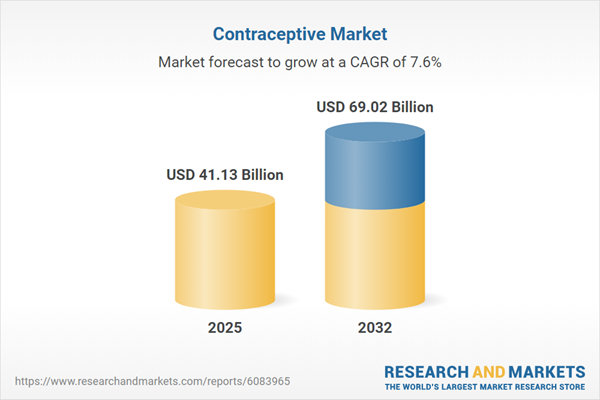Speak directly to the analyst to clarify any post sales queries you may have.
The contraceptive market is navigating a period of significant transition, shaped by changing demographics, evolving technologies, and policy shifts. Senior healthcare executives and investors are seeking in-depth, actionable insights to maximize growth opportunities and strengthen market positioning amid these critical dynamics.
Market Snapshot: Global Growth and Outlook in the Contraceptive Market
The contraceptive market grew from USD 38.40 billion in 2024 to USD 41.13 billion in 2025. It is expected to continue growing at a CAGR of 7.60%, reaching USD 69.02 billion by 2032. Expansion is driven by rapid innovation in digital health, increasing accessibility, and supportive policy frameworks. Growth is observed across pharmaceutical and device-based solutions, with market stakeholders emphasizing reliable and integrated approaches to reproductive health management.
Scope & Segmentation: In-Depth Market Analysis
This report examines the contraceptive market across major segments, providing senior decision-makers with a comprehensive perspective:
- Type: Emergency contraceptives (IUDs, pills), hormonal solutions (implantables, injectables, oral, transdermal), non-hormonal options (barrier methods, herbal—ayurvedic and homeopathic, natural methods), and permanent procedures (tubal ligation, vasectomy).
- Formulation: Patches, monophasic and multiphasic pills, vaginal rings.
- Mode of Action: Preventing implantation, spermicidal action, ovulation suppression.
- Material Type: Latex-based and non-latex alternatives (nitrile, polyisoprene, polyurethane).
- Duration: Long-term and short-term solutions.
- Usage Frequency: On-demand and regular use methods.
- Sales Channel: Offline (hospital and community pharmacies), online (e-commerce platforms, online pharmacy).
- Application: General and post-coital use.
- End-User: Female cohorts (adolescents, adults, post-menopausal) and male populations.
- Regions Covered: Americas (North America, Latin America), Europe, Middle East & Africa, and Asia-Pacific, with sub-regional and market-specific insights.
- Key Companies Profiled: Abbvie Inc., Bayer AG, Cipla Limited, Johnson & Johnson Services, Inc., Lupin Limited, Merck & Co., Inc., Pfizer Inc., Sanofi S.A., Teva Pharmaceutical Industries Ltd., Viatris Inc.
Key Takeaways for Senior Leaders
- Surging demand for patient-centric digital solutions is reshaping user expectations, prompting integration of telemedicine, app-based adherence tools, and omnichannel engagement models.
- R&D investment is intensifying around non-hormonal and sustainable materials, with herbal and biodegradable product lines increasingly appealing to eco-conscious and health-sensitive segments.
- Policy reforms in select markets are improving over-the-counter access, empowering pharmacists and fostering collaborations between pharmaceutical firms and technology startups.
- Regional differences remain pronounced, necessitating tailored go-to-market strategies that reflect local regulatory landscapes, cultural preferences, and infrastructure capabilities.
- Strategic partnerships—particularly between large pharmaceutical firms, nimble biotech ventures, and contract manufacturers—enhance competitive advantage and accelerate innovation pipelines.
Impact of 2025 Tariffs on Supply Chains and Production
Revised tariffs by the United States in 2025 on raw materials and pharmaceutical products have increased production and distribution costs. This has triggered shifts in procurement strategies and encouraged nearshoring, as companies seek to balance cost structures and maintain supply chain resilience. The necessity for operational flexibility and responsive inventory management is accentuated by these external pressures, with cross-regional partnerships emerging to maintain continuity of care and service delivery.
Methodology & Data Sources
The analysis uses a hybrid methodology, combining in-depth executive interviews, clinical stakeholder input, and policy analysis with comprehensive desk research. Rigorous data triangulation, scenario analysis, and advanced statistical tools ensure the validity and relevance of all insights presented.
Why This Report Matters
- Enables senior leaders to identify growth areas, mitigate market risks, and inform investment strategies with a validated, data-driven foundation.
- Offers actionable recommendations on digital integration, supply chain agility, and segment-specific product development to secure sustained competitive advantage.
Conclusion
This report equips decision-makers with the strategic clarity and actionable intelligence needed to navigate the evolving contraceptive market. Executives can leverage these insights to refine commercial strategies, drive innovation, and enhance resilience in a changing global environment.
Table of Contents
3. Executive Summary
4. Market Overview
7. Cumulative Impact of Artificial Intelligence 2025
Companies Mentioned
The companies profiled in this Contraceptive market report include:- Abbvie Inc.
- Bayer AG
- Cipla Limited
- Johnson & Johnson Services, Inc.
- Lupin Limited
- Merck & Co., Inc.
- Pfizer Inc.
- Sanofi S.A.
- Teva Pharmaceutical Industries Ltd.
- Viatris Inc.
Table Information
| Report Attribute | Details |
|---|---|
| No. of Pages | 195 |
| Published | November 2025 |
| Forecast Period | 2025 - 2032 |
| Estimated Market Value ( USD | $ 41.13 Billion |
| Forecasted Market Value ( USD | $ 69.02 Billion |
| Compound Annual Growth Rate | 7.6% |
| Regions Covered | Global |
| No. of Companies Mentioned | 11 |









